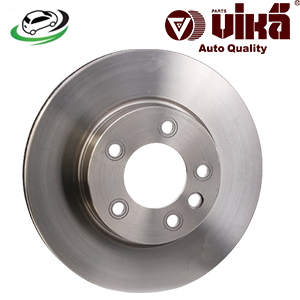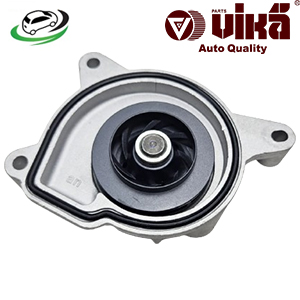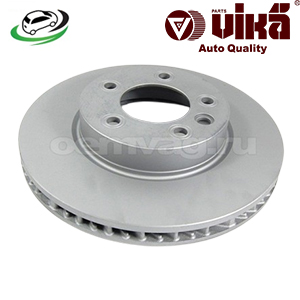-12%
Get Front Left Brake Disc Volkswagen Touareg II 7P5/7P6/Touareg I 7LA/7L6/7L7 7L6615301N
The brake disc, also known as a rotor, is a crucial component of a vehicle’s braking system. It works in conjunction with the brake pads to create the friction necessary to slow down or stop the vehicle. Here’s an in-depth look at the construction, function, benefits, common issues, and maintenance of brake discs.
Construction and Function of a Brake Disc
Construction:
- Material:
- Cast Iron: The most common material used for brake discs due to its excellent heat resistance and wear characteristics.
- Carbon Composite: High-performance vehicles often use carbon composite discs, which are lighter and provide better heat dissipation but are more expensive.
- Ceramic: Ceramic brake discs are used in high-end and racing applications for their superior heat resistance and longevity.
- Design:
- Solid Discs: A solid piece of metal, typically used in smaller or older vehicles.
- Vented Discs: Feature internal vanes between two disc faces to improve cooling by allowing air to flow through the disc.
- Drilled or Slotted Discs: Have holes or slots to improve heat dissipation, reduce weight, and enhance braking performance in wet conditions.
Function:
- Friction Generation:
- Contact with Pads: When the brake pedal is pressed, the brake pads clamp onto the brake disc, generating friction.
- Heat Conversion: This friction converts kinetic energy into heat, slowing down the vehicle.
- Heat Dissipation:
- Cooling: The design of the brake disc helps dissipate the heat generated during braking to prevent overheating and maintain braking efficiency.
- Rotational Deceleration:
- Slowing the Wheels: The friction between the brake pads and disc reduces the rotational speed of the wheels, bringing the vehicle to a stop.
Benefits of a Brake Disc
- Efficient Braking Performance:
- Responsive Braking: Provides quick and efficient stopping power, essential for vehicle safety.
- Consistent Performance: Maintains consistent braking performance even under high-stress conditions.
- Heat Management:
- Cooling: Vented, drilled, or slotted discs offer better cooling, reducing the risk of brake fade during prolonged or intense braking.
- Thermal Stability: High-quality materials ensure that the brake disc can withstand high temperatures without warping or losing effectiveness.
- Durability and Longevity:
- Wear Resistance: Durable materials and robust construction ensure a long service life.
- Corrosion Resistance: Some discs are coated or made from materials that resist corrosion, extending their lifespan.
- Improved Safety:
- Shorter Stopping Distances: Efficient brake discs contribute to shorter stopping distances, enhancing vehicle safety.
- Stable Braking: Provides stable and predictable braking performance, reducing the risk of accidents.
Common Issues with Brake Discs
- Warping:
- Heat Damage: Excessive heat can cause the brake disc to warp, leading to vibrations and uneven braking.
- Improper Installation: Incorrect installation or tightening of the wheel can also cause warping.
- Scoring and Grooving:
- Pad Wear: Worn brake pads can create grooves or scores on the disc surface, affecting braking efficiency.
- Debris: Debris caught between the pad and disc can cause scoring.
- Cracking:
- Thermal Stress: Rapid changes in temperature can cause cracks in the brake disc.
- High-Performance Use: Extreme use, such as in racing, can lead to stress cracks.
- Corrosion:
- Environmental Exposure: Exposure to moisture and road salt can cause the brake disc to rust, especially if the vehicle is not used regularly.
- Material Quality: Lower-quality materials are more susceptible to corrosion.
- Thickness Variation:
- Uneven Wear: Uneven pad pressure or disc wear can result in variations in thickness, causing vibrations and reduced braking efficiency.
Signs of a Failing Brake Disc
- Vibrations:
- Steering Wheel Shaking: Warped discs can cause the steering wheel to shake during braking.
- Brake Pedal Pulsation: A pulsating brake pedal is a common sign of disc issues.
- Noises:
- Squealing or Squeaking: High-pitched noises during braking can indicate worn or damaged discs.
- Grinding: A grinding noise suggests that the brake pads have worn down to the metal, causing damage to the disc.
- Reduced Braking Performance:
- Longer Stopping Distances: Worn or damaged discs can increase stopping distances.
- Brake Fade: Overheating can cause brake fade, reducing braking efficiency.
- Visual Inspection:
- Visible Damage: Cracks, grooves, or rust on the disc surface are clear indicators of issues.
- Thickness Variation: Uneven wear or noticeable thin spots on the disc.
Maintenance and Replacement of Brake Discs
- Regular Inspections:
- Visual Checks: Regularly inspect brake discs for signs of wear, damage, or corrosion.
- Thickness Measurement: Measure disc thickness to ensure it meets manufacturer specifications.
- Proper Installation:
- Professional Service: Have brake discs installed by a professional to ensure proper alignment and torque specifications.
- Torque Specifications: Follow the manufacturer’s torque specifications when tightening the wheels to prevent warping.
- Quality Components:
- High-Quality Parts: Use OEM or high-quality aftermarket brake discs to ensure reliability and performance.
- Matching Pads: Use brake pads that are compatible with the brake discs for optimal performance and longevity.
- Timely Replacement:
- Replace When Worn: Replace brake discs when they reach the minimum thickness specification or show signs of significant wear or damage.
- Pad Replacement: Replace brake pads at the same time as discs to ensure even wear and optimal performance.
- Proper Driving Habits:
- Avoid Hard Braking: Minimize hard or aggressive braking to reduce heat buildup and wear.
- Cool Down Periods: Allow the brakes to cool down between high-stress braking periods, especially after heavy use.
Follow us on Facebook for more parts.





